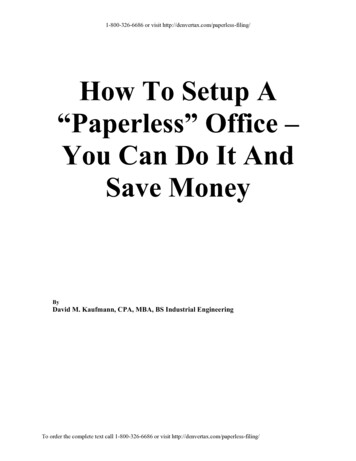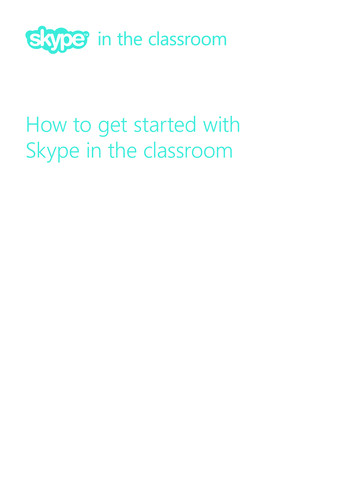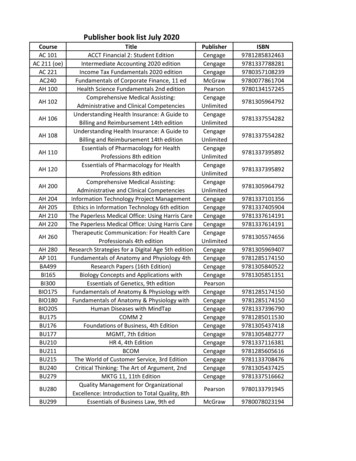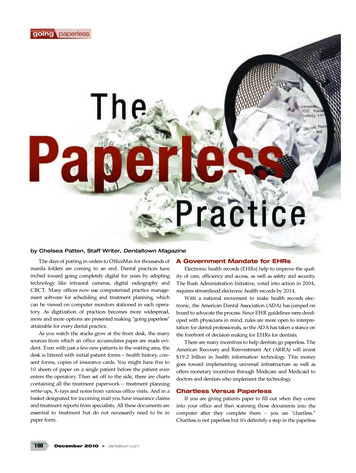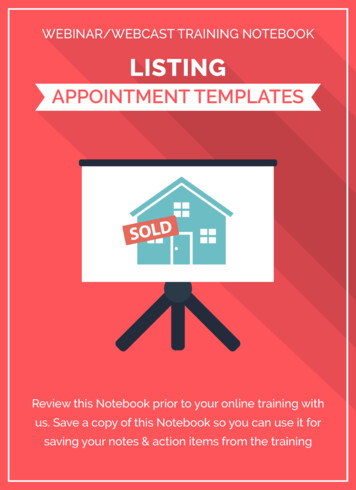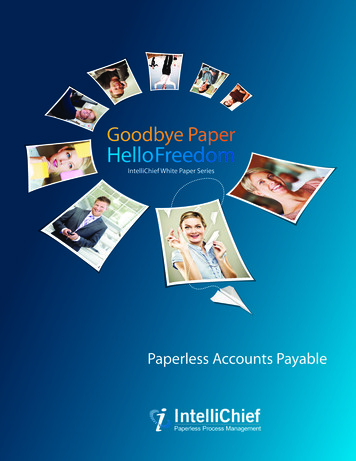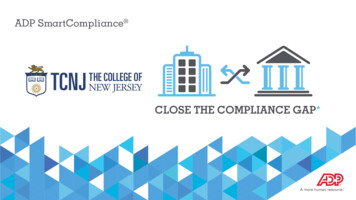
Transcription
Journal of Instructional PedagogiesCreating a paperless classroom with the best of two worldsJeremy Fei WangMarietta CollegeABSTRACTThe information age has presented unprecedented opportunities for educators to digitizetraditional classrooms, an evolution that can empower instructors to extend the channels ofknowledge dissemination and unleash the learning power of students from the manacles ofphysical classrooms. Since the early adoption of the Internet technology by educationalinstitutions, various studies have been done to explore the conceptualization of the paperlessclassroom, focusing on its theoretical framework and impact on traditional learning environment.This paper aims to present a hands-on developmental framework that brings together the best oftwo worlds – online academic course management and industry-class collaboration into a stateof-the-art paperless classroom.Keywords: Paperless Classroom, e-Learning, Virtual Classroom, WebCT, Domino Web AccessCreating a paperless, Page1
Journal of Instructional Pedagogies1. INTRODUCTIONEducators in the 21st century are vested with the task of preparing students for theemergence of an information society (Slowinski, 2000). To face this challenge, since theinception of the new Management Information Systems (MIS) program at Marietta College in2004, the department ventured to create a complete digital environment where the exchange ofphysical materials between the MIS instructor and students is virtually eliminated. Theadaptation of the paperless classroom in the MIS courses has proved to be a strong catalyst forimproved learning conditions, which help to dissolve the physical classroom walls and allow theinstructor and students to continue conversation outside the boundaries of time and space. Theinnovative implementation of the academic flagship product WebCT and industry-classcollaboration tools (IBM Lotus Domino Web AccessTM and TeamRoomTM) in the classroomempowers students to fully utilize the benefits of the Internet in their learning process and getwell prepared for future working environment. In this paperless classroom, students are engagedin various learning activities online, such as reviewing course materials, locating resources,taking quizzes/exams, submitting assignments, receiving grades and feedback, managing teamprojects and collaborating with teammates and the instructor.Rea et al. point out that the traditional approach to course instruction involves little or notechnology, where students and faculty interact face to face in the classroom or during officehours and may continue communicate using low technology approaches, such as telephone orlibrary reserves. This approach represents the industrial-based model and certainly can notprepare students for the information age (Rea, White, McHanley and Sanchez 2000). Comparedwith the traditional approach, the paperless classroom pedagogical approach employed by thishands-on study exemplifies a wide range of benefits to students, including: an anytime and anywhere learning environment where the instructor’s assistance isonly a couple of clicks away; students’ questions are answered promptly a set of convenient tools to manage course materials and team projects strong knowledge management (KM) capabilities a transition to active and hands-on learning a learning community in which students feel always connected useful online skill sets that will prepare them for the digital future2. DEVELOPMENT OF A FRAMEWORK FOR PAPERLESS CLASSROOMThe emergence of the paperless classroom was initially driven by needs to reduce the useof physical materials in classrooms and fueled by the underlying Internet technology (Slowinski,2000). Since its early adoption, a large number of paperless classrooms have been developed incutting-edge U.S. colleges and universities. Unfortunately, anecdotal evidence shows that muchof this storm of development has been undertaken in haste, without expert preparation orknowledge of the process. The lack of system analysis and design has crippled many of thesepaperless classrooms, leaving them incapable of fulfilling the envisioned educational goals(Lynch, 2002). Thus, during the system analysis phase of this study, the interaction of the twomain entities - instructor and student has been carefully examined and a list of key functionalitiesCreating a paperless, Page2
Journal of Instructional Pedagogiesneeded for the paperless classroom have been identified. Table 1 shows a list of these keyfunctionalities identified by this study.Table 1: Paperless Classroom System AnalysisCourse ManagementDesiredFunctionalitiesOnline SyllabusCourse CalendarCourse MaterialsAssignmentQuiz/ExamPerformance InstructorStudent Create well-formatted syllabuswithout knowing the details ofHTML Post individual calendar entrythrough a web form Reuse course calendar entries byimporting a compiled text file Post reading materials in variousformats Upload lecture notes Create links to downloadablerecourses View syllabusonline with anybrowsers Post well-formatted assignmentswith the help of WYSIWYG tools Add comments to submittedassignment files (MS Word format) Post feedback document Assign grades Create a highly customizablequestion bank that supports varioustypes of test questions Batch upload questions though thefile import of a simple text file Grade essay questions and releasetest scores Release all test and assignmentscores Export scores to spreadsheetapplication for grade calculation Post midterm and final grades View the coursecalendar in differentformat View readingmaterials online Download lecturenotes Download courserelated softwarepackages View assignmentmaterials online Upload assignmentfiles Read detailedfeedback document View grades Take web-basedtests Review correctquestions and scores Review old tests Keep track ofgrades onlineFeatures: a messaging system that supports group collaboration discussion forums virtual team spaces that improve team project managementCreating a paperless, Page3
Journal of Instructional PedagogiesSynchronousCommunicationFeatures: real time chat – virtual office hours white board sessions remote assistanceTo achieve the goals stated in the above system analysis, this hands-on study brought togetherthe best of two worlds – the academic courseware management tool WebCT and the industryclass collaboration suite Domino Web AccessTM and TeamRoom TM into this state-of-the-artpaperless classroom. WebCT is a leading web-based courseware management system with strongcustomization capabilities and comprehensiveness. IBM/Lotus Domino Web AccessTM offerssophisticated web messaging capabilities and delivers a highly flexible and reliable collaborationplatform. Domino TeamRoomTM provides an efficient virtual team space that requires minimumsystem setup and configurations with its ready-to-use database template. A logical design on theintegration of these tools is developed by this hands-on study around the situated cognitionmodel to ensure student learning effectiveness. Following the design guidelines for motivationalcourses suggested by Keller and Burkman (1993), this study aims to design a paperlessclassroom that would spark student interests, show the relevance of course materials andknowledge to real-world situations, promote user expectancy by adhering to good navigational,graphic and text design practices and eventually ensure student satisfaction in learning newmarketable skills. Figure 1 depicts the development framework designed by this hands-on studyto integrate these disparate systems seamlessly into the paperless classroom, in which eachsystem plays an integral role in enhancing the student learning experience.Figure 1: Development Framework Designed by the Hands-on StudyCreating a paperless, Page4
Journal of Instructional Pedagogies2.1 Student RegistrationAs the instructor’s process row in Figure 1 shows, the student registration at MariettaCollege is handled by Datatel’s WebAdvisor solution, which feeds student registration data toWebCT through a nightly batch process. Since the data feed is not bidirectional, WebCTinstructors need to manually remove students who drop the course during the add/drop period.The final name list can then be exported to a text file, as shown in Figure 2, which are used foruser registration on the IBM/Lotus Domino server.Figure 2: Domino User Registration Import Text FileDuring the Domino user registration process, student email databases are created on theDomino server and student user profiles are added to the Domino server directory, as illustratedin Figure 1. To enable the web browser-based client Domino Web AccessTM, the Domino mailsystem option needs to be specified as Domino Web Access (Figure 3).Figure 3: Domino Mail Database OptionCreating a paperless, Page5
Journal of Instructional Pedagogies2.2 Online SyllabusThe next step in the instructor’s process flow depicted in the development framework isto create a good online syllabus that provides a course road map. The grading scale included inthe syllabus allows students to keep track of the grades throughout the semester. The WebCTsyllabus tool offers excellent customization capabilities for instructors to create rich-contentonline syllabus without prior knowledge of HTML. Since the syllabus tool supports embeddedHTML, a good practice is to develop the syllabus content as a web page in Microsoft Wordapplication and copy the underlying HTML code into the WebCT syllabus editor (Figure 4).Students can then access the well formatted syllabus anytime and anywhere. This technique canbe used to create other rich web contents in WebCT, such as assignment description anddiscussion topics.Figure 4: Import HTML Code from MS Word to Display Complex Web ContentCreating a paperless, Page6
Journal of Instructional Pedagogies2.3 Course CalendarThe online course calendar is a great feature in WebCT, highly customizable and easy touse. As the paperless classroom development framework (Figure 1) shows, instructors can batchupload the calendar entries for a whole semester through an import text file (Figure 5) and makead hoc changes if necessary. The online calendar reminds students to read assigned readingmaterials, prepare for in-class discussions and submit assignments online.Figure 5: Calendar Entry Import Text File2.4 Course MaterialsThe next step proposed in the development framework is to add good course materialswhich are needed to ensure the learning effectiveness of the paperless classroom. This is wherethe paperless classroom dissolves the physical walls and facilitates the anytime and anywhereknowledge dissemination. The WebCT page management tool offers a variety of options to addthe course materials through the combination usage of Organizer Page, Single Page and URL. Alist of chapters from the textbook is posted on organizer pages and lecture notes, self-studyCreating a paperless, Page7
Journal of Instructional Pedagogiesquestions and relevant online resources are posted logically under each chapter. These materialswill help students to internalize the concepts learned in class. Hands-on lab materials, includingPowerPoint slides, PDF lab manuals and software packages can also be posted under Labsessions (Appendix 3 and 4). While in this paperless classroom, students can seek help by usingthe class collaboration tools, such as sending an email to or scheduling an appointment with theinstructor through the Domino Web Access TM messaging system, posting a question in the classdiscussion forum or chatting with the instructor during virtual office hours (Figure 1).2.5 Online TestsAs shown in the development framework, to evaluate students’ performance, instructorscan use a set of powerful WebCT tools to setup online tests (Figure 6), which support true/false,multiple choice, short-answer and essay questions. These questions can be setup in the questionbank by importing a plain text file (Figure 7), which dramatically cuts down the setting up timeand allows reuse of the questions. The true/false and multiple choice questions can beautomatically graded. Short-answer or essay questions need to be graded by the instructor andthe results are then posted online. From here, students can use the collaboration tools to checkwith the instructor if there are any issues.Figure 6: Online Test in WebCTCreating a paperless, Page8
Journal of Instructional PedagogiesFigure 7: Test Question Import Text File2.6 Online AssignmentInstructors can also post individual or team assignments by using the WebCT assignmenttool (Figure 1). This online assignment feature virtually eliminates the exchange of physicalmaterials between students and instructor, which exemplifies the convenience and cost savingadvantages of the paperless classroom. Online assignments can be easily posted by importing theHTML code from Microsoft Word web pages (as discussed in 2.2). A good practice is to providedetailed feedback by using the Microsoft Word comment tool on submitted Word documents andattach the modified documents along with the grades. Students find this type of feedback moreinformative and easy to follow (Figure 8). Students can also use the collaboration tools to ask theinstructor questions and collaborate on team assignments.Figure 8: Assignment FeedbackCreating a paperless, Page9
Journal of Instructional Pedagogies2.7 Asynchronous CommunicationAs the development framework (Figure 1) illustrates, the IBM/Lotus Domino WebAccess is the main asynchronous communication tool deployed in the paperless classroom. Thisenterprise collaboration tool greatly facilitates the exchange of information and also helps toprepare students for the future working environment. Table 2 illustrates some of the bestpractices adopted in the framework.Table 2: Domino Web Access Best PracticesBest PracticesImplementationClass distribution lists can be easily created and maintained in the Dominoserver directory. The instructor and students can send out emails to the wholeclass or certain teams conveniently.Class DistributionListsOnlineAppointmentsStudents can use the powerful calendar tool of Domino Web Access TM to checkthe instructor’s free time and make appointments online. This feature can alsohelp students coordinate team meetings during group projects.Creating a paperless, Page10
Journal of Instructional PedagogiesFor team projects, students can create a group calendar to keep each otherinformed of their personal schedules, which facilitates the communicationamong team members.Group CalendarThe paperless classroom also features the Domino TeamRoom TM, which offers a virtualteam space for students to share research materials, drafts and online resources with other teammembers and manage project milestones. Each TeamRoomTM is secured for the authorized teammembers only (Figure 9). Students can first review the detailed project description posted inWebCT, and then they can collaborate with other team members through Domino Web Accessand Domino TeamRoom, which are seamlessly integrated with the WebCT, as illustrated in thedevelopment framework (Figure 1).Creating a paperless, Page11
Journal of Instructional PedagogiesFigure 9: Domino Team Room2.8 Synchronous CommunicationThe WebCT chat module is implemented for synchronous communication. Although thevirtual office hour initiatives are welcomed by students, the effectiveness is limited by the lessrobust capability of the WebCT chat tool. The future work section of this paper will discussplans to implement IBM/Lotus SametimeTM.2.9 Grade PostingAll the quiz/exam and assignment results are posted in WebCT and students can checktheir performance through the My Grades tool. By referring to the grading scale included in theonline syllabus, they will be able to verify any discrepancy between the instructor’s calculationand theirs. A good practice is to export the results from WebCT to an Excel spreadsheet and thenuse appropriate formulas to calculate mid-term or final grades. This dramatically reduces thegrading work for the instructor. Students are also happy about the fact that their grades arealways transparent to them.To make these different tools work well together in the paperless classroom, navigationlinks should be well planned out to promote the human-computer interaction. Esnault andZeiliger (2000) reiterate that special attention should be given to the course structure and to thenavigation features which very often come as an outcome. Based on the logical flow of thedevelopment framework (Figure 1), the navigation links are grouped into four major categories:1) Course Content 2) Course Evaluation 3) Collaboration and 4) My Tools (as shown inscreenshot 1 in the appendix). These links are shown in a navigational frame and are alwaysavailable to students while they are viewing various content pages. The intuitive layout helpsstudents to find resources quickly and promote the use of the paperless classroom. Table 3outlines the hyperlinks used in the course navigation pane.Creating a paperless, Page12
Journal of Instructional PedagogiesTable 3: Paperless Classroom CapabilitiesFeaturesOnline CourseCalendarOnlineSyllabusList ofChaptersLab etailed course schedule andrelevant activities in each classsession are posted online.An online syllabus outlines theinstructor’s contact information,class expectations, courserequirements, grading standards anduseful links to online resources.Lecture notes are posted asPowerPoint files for every class.Each chapter also contains a set ofself study questions online intrue/false and multiple choicequestion formats. Students willreceive feedback right away afterthey complete the questions.Hands-on lab tutorials, case studymaterials and sample works areposted here, which can guide thestudents through the challenging labsessions. Licensed software is alsoavailable for students to downloadand install on their laptops ordesktops.Students are always updatedof the class progress.Detailed assignment description andrequirements are posted withrelevant file attachments orhyperlinks to online resources.Students submit their assignmentsand receive feedback and gradesonline.Short online quizzes are given aftereach chapter in the format ofTrue/False and multiple choicequestions. Essay questions are addedto the final exam.DetailsStudents don’t have to worryabout losing their syllabianymore. The course roadmap is available to them 24hours a day, 7 days a week.Students have access to thePowerPoint notes and tutorialsall the time. The self studyquestions help students tointernalize the key concepts ofeach chapter.With a lab “tutor” online allthe time, students with lowercomputer proficiency levelscan keep up with the progressof the class. By distributingsample works and softwareonline, students can learnfrom the best practices andwork on their projects anytimeand anywhere.Students no longer have toworry about losing assignmentfiles. Detailed feedback isprovided with the MS Wordcomment utility. Students willknow exactly which areas canbe improved.Quizzes are automaticallygraded and students canreview the correct answersafter the results are released.The online quizzes and examshelp students to get moreaccustomed to the computerbased testing (CBT), which isbecoming more prevalent inthe real business 5Appendix6Creating a paperless, Page13
Journal of Instructional PedagogiesDomino WebAccessTMDominoTeamRoomTMMy GradesThis enterprise collaboration tool ismade available to every studentregistered for the course.Each team is provided with a securedonline team place. Only designatedteam members have access.A summary of the results of quizzes,exams and assignments is postedonline and transparent to students.The rich collaboration featuresof this tool greatly facilitatethe communications betweenthe students and the instructor.It also helps to preparestudents for the futureworking environment.Students acquire hands-onexperience on a virtual teamworking environment, whichis widely used in businessnowadays.The online postings of gradeshelp students to accuratelytrack their progress in class.Appendix7Appendix8Appendix93. SUMMARY AND FUTURE WORKThe paperless classroom serves an important role in preparing students for the 21stcentury, offering them an environment where they can learn the skill sets are important for thedigital future. This paper describes a development framework and its implementation in a stateof-the-art paperless classroom, which brings together the best practices from both worlds. Thishands-on study has shown that students are highly motivated to use the paperless room and reapthe benefits it offers. An online survey was sent out to students who have completed theIntroduction to Management Information Systems course. The survey results were very favorablewith all categories in the "agree" and most between agree and strongly agree. The following tablesummarizes the survey results.Table 4: Summarized ResultsQuestionsMeanStandardDeviation1. Overall, the online tools (WebCT, Domino Web Access,TeamRoom) help me greatly in learning the MIS220 course.4.230.632. The paperless course environment helps me to better managethe course materials and access information.4.230.683. The online tools help me to better collaborate with myteammates and the instructor4.000.834. The online tools have created an anytime and anywherelearning environment. I feel more connected to theinstructor.4.400.675. The industry standard online tools prepare me better for4.300.65future team working environmentScale - 5: Strongly Agree 4: Agree 3: Neither 2: Disagree 1: Strongly DisagreeCreating a paperless, Page14
Journal of Instructional PedagogiesThe next goal of this study will be to continue searching for ways to make the paperlessclassroom more robust, intuitive and efficient. One weak area of the current paperless classroomis the synchronous communication module, which does not fulfill student needs that well. Thelatest Instant Messaging (IM) solution SameTimeTM from IBM/Lotus is being evaluated and apilot study will be launched to integrate this leading industry IM tool into the paperlessclassroom. The digitization of the traditional classroom has just begun.REFERNCESAdams, W. J. and Jansen, B.J. (1997) “Information technology and the classroom of the future.”Society for Information Technology in Education Conference. Orlando, Florida.Biesenbach-Lucas, S. (2004). “Asynchronous web discussions in teacher training courses:Promoting collaborative learning—or not?” AACE Journal, 12(2), 155-170.Esnault, L., and Zeiliger, R. (2000) “Web Learning with Nestor: The Building of a NewPedagogical Process,” in A. Aggarwal (ed) Web-Based Learning and TeachingTechnologies: Opportunities and Challenges, Idea Group Publishing.Heo, M. (2003) “A Learning and Assessment Tool for Web-based Distributed Education”CITC4 2003, October 16–18, 2003, Lafayette, Indiana, USA.IBM/Lotus (2006) “Lotus Domino Web Access, A member of the IBM Workplace family”,February, 2006. Available s/product1.nsf/wdocs/webaccesshomeKaddah, M., Mansour M., Kaliouby R., and Ayyat, S. L. (2002) “From a Generic to aCustomized Framework: Paving the way for WebCT” Proceedings of the Syllabus Fall2002 Conference (November, 2002), Boston, MA.Keller, J., and Burkman, E. (1994) “Motivation Principles,” in M. Fleming and W. H. Levie (eds)Instructional Message Design: Principles from the Behavioral and Cognitive Sciences,2nd edition, Englewood Cliffs NJ: Educational Technology Publications.Lynch, M. (2002). The Online Educator: A guide to creating the virtual classroom,RoutledgeFalmer NY.Rea, A., White, D., McHaney, R. and Sanchez, C. (2000) “Pedagogical Methodology in VirtualCourses,” in A. Aggarwal (ed.) Web-based learning and teaching technologies:opportunities and challenges, 138-139, Idea Group.Slowinski, J. (2000) “Flaunt IT: Construction of a Paperless Classroom,” in L. Mealy and B.Loller (eds) e-learning: Expanding the Training Classroom through Technology, 117-127,IHRIM, Inc.WebCT (2006) WebCT Campus Edition Course Management System, March 2006. Available tID 6205796APPENDICES – DETAILED SCREENSHOTS1. Welcome Page & CalendarIn the welcome page, a brief description of the tools helps students to get familiarized with the paperlessclassroom environment. They can also download the syllabus in either MS Word or PDF file format.Creating a paperless, Page15
Journal of Instructional PedagogiesThe navigation pane is logically separated into four sections: Course Content, Course Evaluation,Collaboration and My Tools, which help students to locate resources and navigate through the paperlessclassroom more efficiently.Creating a paperless, Page16
Journal of Instructional PedagogiesDetailed course schedule is posted on the WebCT calendar. Ad hoc updates can be easily posted here aswell.2. Online SyllabusAn online syllabus is always available to the students.Creating a paperless, Page17
Journal of Instructional Pedagogies3. List of ChaptersLecture notes and self study questions that accompany the textbook are available to students 24 hours aday, 7 days a week.Self-study guide, lecture notes and self-testquestions are available for each chapter covered.Lecture notes are available in MS PowerPoint format.Students can download these files to review the keyconcepts discussed in class.Interactive self study guide is a great feature to help students review the key concepts.Creating a paperless, Page18
Journal of Instructional Pedagogies4. Lab SessionsHands-on lab tutorials, notes and software are posted online to guide students through the “maze” of IT projects.5. AssignmentClass assignments are all managed online, including postings of assignment requirements, relevant attachments,submission and feedback.Creating a paperless, Page19
Journal of Instructional Pedagogies6. Quiz & ExamAll quizzes and exams are administered online, in the format of true/false, multiple choices and essay questions.7. Domino Web AccessEvery registered student is given access to use this enterprise collaboration tool through the department intranet,which greatly facilities the class communications. Students can send rich-featured emails, invite team membersfor team meetings, schedule appointments with the instructor and manage personal calendars and to do listsonline.Creating a paperless, Page20
Journal of Instructional Pedagogies8. Domino TeamRoomCreating a paperless, Page21
Journal of Instructional PedagogiesEach team is provided with a secured virtual team space, where they can manage various project relatedactivities online.9. My GradesThe results of all quizzes, exams, assignments and team projects are posted here. Students can accurately trackthe progress of their work and discuss any discrepancies with the instructor right away.Creating a paperless, Page22
useful online skill sets that will prepare them for the digital future 2. DEVELOPMENT OF A FRAMEWORK FOR PAPERLESS CLASSROOM The emergence of the paperless classroom was initially driven by needs to reduce the use of physical materials in classrooms and fueled by the underlying Internet technology (Slowinski, 2000).
